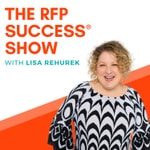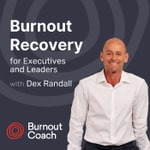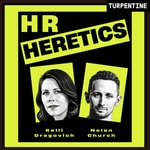The RFP Success Show – Détails, épisodes et analyse
Détails du podcast
Informations techniques et générales issues du flux RSS du podcast.

The RFP Success Show
Lisa Rehurek
Fréquence : 1 épisode/16j. Total Éps: 142

Classements récents
Dernières positions dans les classements Apple Podcasts et Spotify.
Apple Podcasts
🇬🇧 Grande Bretagne - management
31/07/2025#91🇨🇦 Canada - management
30/05/2025#71🇨🇦 Canada - management
08/05/2025#61🇨🇦 Canada - management
06/02/2025#64🇨🇦 Canada - management
29/10/2024#67
Spotify
Aucun classement récent disponible
Liens partagés entre épisodes et podcasts
Liens présents dans les descriptions d'épisodes et autres podcasts les utilisant également.
See all- https://www.upwork.com/
1875 partages
- https://zoom.us/
664 partages
- https://slack.com/
626 partages
- https://www.linkedin.com/in/lisarehurek/
137 partages
- https://www.linkedin.com/groups/13544204/
53 partages
Qualité et score du flux RSS
Évaluation technique de la qualité et de la structure du flux RSS.
See allScore global : 63%
Historique des publications
Répartition mensuelle des publications d'épisodes au fil des années.
This Week on The RFP Success® Show: Mastering the Response Maze! EP143
lundi 7 octobre 2024 • Durée 16:37
What is the #1 question we’re getting about RFPs from clients and prospects lately?
Is it a tactical question about time management, contradictory requirements, or formatting? Or a high-level question about managing stress and continuous improvement?
On this episode of The RFP Success Show, Lisa Rehurek tackles some of the most frequently asked questions about navigating RFPs. From mastering time management to handling contradictory requirements and managing stress, Lisa shares her expert advice to help you streamline your RFP response process.
Key Takeaways
-
Mastering Time Management
- Create a Timeline: Break tasks into manageable chunks and work backwards from the due date to ensure timely completion.
- Prioritize Critical Sections: Focus on the evaluation criteria and allocate time accordingly.
- Set Milestones: Establish key checkpoints and create a calendar with blocked time for uninterrupted work.
-
Navigating Contradictory Requirements
- Clarify with Issuer: Use the Q&A period to address any contradictions and avoid confusion.
- Document Everything: Keep thorough records of clarifications and decisions for future reference.
- Use a Compliance Matrix: Develop a matrix to track requirements and identify contradictions early.
-
Response Formatting Strategies
- Understand Guidelines: Build your response template to meet formatting requirements from the start.
- Be Creative Within Constraints: Use visuals and bullet points to make your proposal engaging while adhering to guidelines.
- Create and Customize Templates: Maintain a library of templates to streamline response preparation and ensure clarity.
-
Stress Management Techniques
- Take Breaks: Regular breaks can boost creativity and reduce stress.
- Stay Organized: Keep all documents and drafts well-organized to avoid chaos.
- Celebrate Small Wins: Recognize and celebrate progress to maintain motivation.
- Commit to Continuous Improvement: Post-submission reviews help refine your process for future RFPs.
The RFP Success Company on YouTube
The RFP Success Company on LinkedIn
Email podcast@rfpsuccess.com
ResourcesThe Role of Contracts in Successful Prime + Sub Partnerships on RFP Success EP036
How to Develop Your RFP Pricing Strategy on RFP Success EP081
Book a Call with the RFP Success Company
The RFP Success Book by Lisa Rehurek
Power Up Your Proposals: Master AI Prompts on This Week's Podcast! EP142
mardi 1 octobre 2024 • Durée 18:55
What’s the secret to getting the most out of AI when crafting RFP proposals?
Is it about using AI to generate quick responses, or are there specific strategies to fine-tune the AI’s output for high-quality, customized proposals?
In this episode of The RFP Success Show, Lisa Rehurik dives into how to create effective AI prompts that will elevate your RFP responses. Lisa explains why the key to strong AI-generated content is in how you prompt it and shares tips on getting the best results by being specific, providing context, and asking for iterations.
She also breaks down the most common mistakes people make when working with AI, including being too vague or overloading the system with too much information. Tune in to learn how to craft prompts that transform your standard replies into winning proposals and ensure your content still feels personalized, not just automated.
Key Takeaways:-
Why AI prompts are crucial to RFP success
Better prompts lead to more accurate and relevant AI-generated content, helping you save time while producing high-quality responses. -
How to structure your AI prompts effectively
Specificity, providing context, and using examples are essential for tailoring AI outputs to your proposal needs. -
The importance of refining AI-generated content
Never copy and paste—always customize AI outputs to align with your client’s needs and your brand’s voice. -
Using AI for creativity and iteration
Ask AI for multiple versions of a response, which can spark new ideas and refine your strategy for winning proposals. -
Common pitfalls when using AI for proposals
Avoid vague prompts and overwhelming the AI with too much detail. Balance is key to getting the most out of the tool
Connect with Lisa
The RFP Success Company on YouTube
The RFP Success Company on LinkedIn
Email podcast@rfpsuccess.com
ResourcesThe Role of Contracts in Successful Prime + Sub Partnerships on RFP Success EP036
How to Develop Your RFP Pricing Strategy on RFP Success EP081
Book a Call with the RFP Success Company
The RFP Success Book by Lisa Rehurek
How to Set Yourself Apart in an RFP Response - EP133
Épisode 133
mercredi 9 août 2023 • Durée 24:17
How do you set yourself apart in an RFP response?
We recently helped a small business client get their first RFP win. And they were up against some big players in their industry.
So, what did they do to stand out among the competition?
On this episode of The RFP Success Show, I’m discussing three categories of content that will take you from MEETS to EXCEEDS expectations on your next proposal response.
I explain how to demonstrate DISTINCTION in an RFP and share our top three strategies for catching and keeping an evaluator’s INTEREST to get the score you deserve!
Listen in for insight on identifying your VALUE PROPOSITION in a proposal response and find out how our upcoming RFP Success Accelerator can teach you to set yourself apart in an RFP.
Key Takeaways3 categories of RFP content that will take you from MEETS to EXCEEDS expectations
How we define distinction as setting yourself apart from everyone else who submits a bid
What it looks like to demonstrate industry credibility in your writing
How to identify your differentiators and why they can’t be something your competitors do
Why it’s crucial to catch and keep an evaluator’s interest in an RFP
Our top 3 strategies for keeping an evaluator’s interest (even if they’re skimmers)
How we define value proposition as the benefits of your product or service
Why your value proposition should change based on the specific RFP opportunity
Connect with LisaThe RFP Success Company on YouTube
The RFP Success Company on LinkedIn
Email podcast@rfpsuccess.com
ResourcesGet on the RFP Success Accelerator Waitlist
Don’t Miss the September 6 LIVE Webinar
How to Enable the Readability Feature in Word
Sentence Length Comprehension Study
Book a Call with the RFP Success Company
How to Get Started with RFPs - EP043
Épisode 43
mardi 18 juin 2019 • Durée 26:08
Are you new to the idea of responding to RFPs? If so, you’re probably curious about where to go to find RFP opportunities. And you may also be wondering what the process of responding to a request for proposal looks like. What’s the difference between corporate and government RFPs? What’s the best way to approach the procurement departments of your target customers? Once you’ve identified an opportunity, what steps can you take to prepare a winning response?
Today on the podcast, I’m explaining how to get started with RFPs, discussing how to find opportunities and prepare corporate, state or local government responses. I share the importance of building relationships with people in the organizations and agencies you want to work with and getting notifications when they release an RFP.
I go on to walk you through the process of responding to an RFP, describing how to create a response template, craft a strategy, write and revise the content, and complete the peer review process—in a timely manner! Listen in for insight on learning from the bids you don’t win and get a list of the top resources for identifying opportunities to bid on RFPs.
Key TakeawaysThe challenge of finding corporate RFP opportunities
How to identify corporate targets and get on their vendor lists
How to approach corporate supplier diversity departments
How to get in front of government procurement departments
The best resources for finding local + state government RFPs
A simple, step-by-step overview of the RFP response process
- Read RFP and identify questions
- Create response template
- Reverse engineer calendar
- Think through strategy (theme)
- Get writing done
- Edit for cohesive voice
- Objective peer review
- Editorial peer review
How to get information and learn from the bids you don’t win
Connect with LisaThe RFP Success Community on LinkedIn
Email lisa@lisarehurek.com
ResourcesContracting with the Federal Government on RFP SS EP011
Build Relationships & Win Federal Business on RFP SS EP030
Guiding Technical Experts to Provide Specs for an RFP – with Lisa Rehurek - EP042
Épisode 42
mardi 11 juin 2019 • Durée 14:19
It is simply not fair to expect technical experts to write an RFP response. Yes, you will need their input as you gather information for a given proposal, but it’s your role as the writer to craft the narrative and communicate the value of your team’s solution. So, what can you do to steer the technical experts in the right direction, guiding them to provide the data you need in the most efficient and effective way?
Today on the podcast, I’m explaining how to guide the information you get from technical experts for an RFP response. I address why it’s unfair to expect technical staff to write the proposal you’re going to submit and break down the role of technical experts in providing the HOW and the WHAT of your proposal.
I also describe the role of the proposal writer in compiling the data from technical experts and articulating the value of the solution through the RFP response. Listen in for insight around using tables and writing prompts to gather the information you need and learn how doing the heavy lifting on the front end improves the RFP process!
Key TakeawaysWhy you can’t turn technical staff into proposal writers
The technical expert’s role in providing the WHAT and the HOW
How the proposal writer articulates the value of your solution
How to guide the information you get from technical experts
The value in using the table format to gather specific data
The 4 prompts for technical experts re: narrative questions
- What is the short answer?
- Why does it matter?
- How is our solution different/better? What’s the proof?
- What’s the process for making that happen?
How heavy lifting on the front end improves the RFP process
Connect with LisaThe RFP Success Community on LinkedIn
Email lisa@lisarehurek.com
ResourcesAppealing to Behavioral Styles in Your RFP Response – with Lisa Rehurek - EP041
Épisode 41
mardi 28 mai 2019 • Durée 13:07
What resonates with one evaluator may not appeal to another. Some are skimmers, while others read every word. Some make decisions based on emotion, while others leverage logic. Some are engaged by story, while others are more interested in data. So, how in the world do you write an RFP response that caters to all four behavioral styles? How do you engage ALL the evaluators and win more business?
Today on the podcast, I’m sharing the four behavioral styles and discussing how to garner the attention of each in an RFP response. I share the characteristics of the Social Butterfly and the Slow and Steady types, explaining how both make decisions based on emotion but differ in terms of patience, focus, and willingness to change.
I also address what differentiates the Straight Shooter and Statistical Personality, exploring how the former is accomplishment-driven and focused on efficiency, while the latter makes decisions using data and analysis. Listen in for insight around capturing the attention of a diverse group of evaluators and learn to tier your answers to appeal to all four behavioral styles in an RFP response
Key TakeawaysThe 4 different types of behavioral styles
- Social Butterfly
- Slow and Steady
- Straight Shooter
- Statistical
The characteristics of a Social Butterfly
- Love people and make decisions with emotion
- Skimmers (keep focus with graphics, bullet points)
The characteristics of a Slow and Steady
- Process-oriented and like comfort zone
- Patient, dedicated to evaluation criteria
The characteristics of a Straight Shooter
- Accomplishment-driven, need proof for claims
- Don’t like to waste time and prefer efficiency
The characteristics of a Statistical Personality
- Data-driven and analytical
- Averse to too much fluff
How to tier your answers to appeal to diverse behavioral styles
Connect with LisaThe RFP Success Community on LinkedIn
Email lisa@lisarehurek.com
ResourcesCompeting for Attention with Your RFP Response – with Lisa Rehurek - EP040
Épisode 40
mardi 21 mai 2019 • Durée 15:58
Let’s face it: Evaluators are bored. They’re tired. They’re busy and distracted. So, how is your RFP response going to capture their interest? The fact is, you are not just competing in terms of knowledge and skill, you’re competing for attention span. What can you do to stand out?
Today on the podcast, I’m sharing my top strategies for grabbing—and keeping—the evaluator’s attention in an RFP. I explain how to make a good first impression with a clean proposal and why it’s helpful to break up text with white space, bullet points, tables and checklists. I also discuss the mistakes people make in creating graphics, offering insight on simplifying visuals and choosing information that’s truly important.
I go on to cover the value of establishing an emotional connection, describing how that builds trust with evaluators and increases your chances of winning business. Listen in to understand how a conversational tone can capture attention and learn how to keep an evaluator interested by targeting their head AND heart in your RFP response!
Key TakeawaysHow much time you have to grab the evaluator’s attention
My top strategies for capturing attention through the RFP
- Clean visuals
- Storytelling
- Conversational response
How to make a good first impression with a clean proposal
The value in breaking up text with white space, tables, etc.
The top mistakes people making in proposal graphics
- Info in graphic not important to evaluator
- Too much info presented in single graphic
Why it’s crucial to create an emotional connection in RFPs
How to capture a conversational tone through dictation
Connect with LisaThe RFP Success Community on LinkedIn
Email lisa@lisarehurek.com
ResourcesDifferentiators on RFP Success Show EP39
Mike Parkinson on RFP Success Show EP032
Identifying Your Differentiators for the RFP – with Lisa Rehurek - EP039
Épisode 39
mardi 14 mai 2019 • Durée 19:46
What differentiates your company from its competitors? If your answers are centered around years of experience or passion for what you do, it may be time to rethink your strategy. The truth is, your clients EXPECT you to have a solid background and to care about what you do. So, what REALLY sets you apart? What is true about your company—that your competitors CANNOT claim? And how do you back up those differentiators with proof in an RFP response?
Today on the podcast, I’m discussing the difference between baseline expectations and true differentiators, revealing the ONLY time it’s okay to use an expectation as one of your differentiators in an RFP response. I explain why you can’t just list what sets you apart and describe how to prove your differentiators with statistics, case studies and testimonials.
I also share my 5-step process for identifying differentiators, addressing the importance of interviewing your clients as well as employees at every level of the organization to uncover what makes you better than the competition. Listen in to understand the value in sprinkling your differentiators throughout the RFP response and learn how to lean into what sets you apart and win more business!
Key TakeawaysThe difference between baseline expectations and differentiators
The only time it’s okay to use an expectation as a differentiator
How to prove your differentiators with statistics + case studies
How to identify your differentiators
- Compile list of client expectations
- Brainstorm how better than competition
- Interview clients, review testimonials
- Talk to employees at every level
- Find patterns, identify 3-5 differentiators
The danger of your RFP blending in with the competitors’
The value in sprinkling your differentiators throughout the RFP
Connect with Lisa ResourcesIf at First Your RFPs Don’t Succeed, Get Feedback and Try Again – with Karie Cowden - EP038
Épisode 38
mardi 30 avril 2019 • Durée 25:36
If bidding on RFPs is a growth strategy you’re considering, know that the process is not for the faint of heart. You’re unlikely to win your first or second bid—and maybe not even your third or fourth. At the end of 2017, Karie Cowden and her team at Connect the Dots Promotions went all-in on RFPs, spending more than $10K in 12 months on eight RFP submissions that failed. As 2018 came to a close, the team decided to try a Hail Mary pass, giving themselves until the end of the first quarter to win a bid—or abandon the strategy altogether.
Karie is the Founder and President of Connect the Dots, a marketing agency dedicated to helping clients create an experience around their brand through promotional items. Karie has 25-plus years of experience in the realm of promotional products, and Connect the Dots boasts a diverse international client base ranging from community churches to Fortune 500 companies.
Today, Karie joins us to explain why Connect the Dots made the decision to start bidding on RFPs and how they balance price point with concerns about quality and safety. She shares the team’s heartbreak at investing thousands of dollars’ worth of time and effort on eight unsuccessful RFPs before finally getting help from an outside consultant. Listen in as Karie discusses the changes Connect the Dots made in writing their ninth RFP, describing how they leveraged storytelling and specific data to substantiate their claims—and score their first WIN!
Key TakeawaysHow Connect the Dots creates experiences around client’s brands
Why Karie’s team made the decision to respond to RFPs in 2017
Karie’s challenge in responding to RFPs that focused on price
The frustration Karie faced in responding to 8 RFPs without a win
How Connect the Dots spent $10K+ on unsuccessful RFPs
What finally inspired Karie to get help from an RFP consultant
Why it’s crucial to tell your story through the RFP
How to identify what differentiates you from the competition
How Connect the Dots won their ninth RFP Hail Mary bid
How Karie’s team used pictures and data to win their first RFP
The value in substantiating your claims with testimonials
Karie’s advice around leveraging outside consultants for feedback
Connect with KarieCall (602) 944-5592
Connect with LisaThe RFP Success Community on LinkedIn
ResourcesGetting the Most Out of Microsoft Word for RFPs – with Jen Parkinson - EP037
Épisode 37
mardi 9 avril 2019 • Durée 37:03
If you’ve ever been tasked with putting together an RFP that is hundreds of pages long, you know the pain of formatting glitches, consistency issues, and, worst of all, losing hours of work in a ‘big crash.’ So, are there any ninja tricks to working with Microsoft Word that mitigate these risks?
Jen Parkinson is the cofounder and President of Billion Dollar Graphics, a firm dedicated to giving business professionals the tools to create powerful infographics and presentations. With 23 years of experience designing marketing materials, presentations and government proposals, Jen is an expert in producing bid-winning RFPs and first-class presentations.
Today, Jen joins us to share her top tips and tricks around using Microsoft Word for RFPs. She explains the key differences between Word and InDesign, explaining why Word is prevalent in the proposal world and how to use section breaks to create various page styles in the program. Jen also discusses her preference for submitting RFPs as PDF files and offers advice on mitigating flow issues and maintaining consistency in a document—from one machine to another. Listen in for Jen’s insight on using the Styles, Spacing and Review tools to compose an RFP and learn how to avoid the big crash by saving backup copies and new versions regularly!
Key TakeawaysJen’s path from marketing design to the proposal world
The differences between Adobe InDesign and Microsoft Word
How to use section breaks to create several different page styles
Why it’s crucial to reformat a page before deleting a section break
How to ensure headers and footers match the page orientation
Why Jen prefers submitting an RFP as a PDF vs. a Word file
The importance of using the fonts specified by an RFP
How to keep pictures and captions together by creating a table
How to get your feet wet with Styles by creating headings
When to use the Keep lines together and Keep with next features
Jen’s tips for modifying the leading (line spacing) in a document
The distinction between a header and a heading
Jen’s tricks for using the Review tool to collaborate on an RFP
How to avoid the big crash by saving backup copies + new versions
Connect with JenBillion Dollar Graphics on Facebook
Email info@billiondollargraphics.com
Connect with LisaThe RFP Success Community on LinkedIn
ResourcesBillion Dollar Graphics’ PowerPoint Plugin









